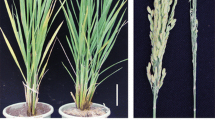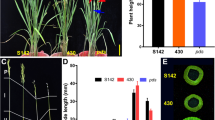Abstract
A floral organ mutant was observed in transgenic Medicago truncatula Gaertn. plants that had two separate stigmas borne on two separate styles that emerged from a single superior carpel primordium. We propose the name bi-pistil, bip for the mutation. We believe this is the first report of such a mutation in this species. Genetic and molecular analyses of the mutant were conducted. The mutant plant was crossed to a mtapetala plant with a wild-type pistil. Expression of the mutant trait in the F1 and F2 generations indicates that the bi-pistil trait is under the control of a single recessive gene. Other modifying genes may influence its expression. The mutation was associated with the presence of a T-DNA insert consisting of the Alfalfa mosaic virus (AMV) coat protein gene in antisense orientation and the nptII selectable marker gene. It is suggested that the mutation is due to gene disruption because multiple copies of the T-DNA were observed in the mutant. The bi-pistil gene was found to be independent of the male-sterile gene, tap. This novel mutant may assist in understanding pistil development in legumes.







Similar content being viewed by others
References
Alonso JM, Stepanova AN, Leisse TJ, Kim CJ, Chen H, Shinn P, Stevenson DK, Zimmerman J, Barajas P, Cheuk R, Gadrinab C, Heller C, Jeske A, Koesema E, Meyers CC, Parker H, Prednis L, Ansari Y, Choy N, Deen H, Geralt M, Hazari N, Hom E, Karnes M, Mulholland C, Ndubaku R, Schmidt I, Guzman P, Aguilar-Henonin L, Schmid M, Weigel D, Carter DE, Marchand T, Risseeuw E, Brogden D, Zeko A, Crosby WL, Berry CC, Ecker JR (2003) Genome-wide insertional mutagenesis of Arabidopsis thaliana. Science 301:653–657
Bagnall DJ, King RW, Whitelam GC, Boylan MT, Wagner D, Quail PH (1995) Flowering responses to altered expression of phytochrome in mutants and transgenic lines of Arabidopsis thaliana (L.) Heynh. Plant Physiol 108:1495–1503
Benaben V, Duc G, Lefebvre V, Hughet T (1995) TE7, an inefficient symbiotic mutant of Medicago truncatula (Gaertn.) cv. Jemalong. Plant Physiol 107:53–62
Benlloch R, Navarro C, Beltran JP, Canas LA (2003) Floral development of the model legume Medicago truncatula:ontogeny studies as tool to better characterize homeotic muations. Sex Plant Reprod 15:231–241
Bowman JL, Smyth DR, Meyerwitz EM (1989) Genes directing flower development in Arabidopsis. Plant Cell 1:37–52
Brill LM, Evans CJ, Hirsch AM (2001) Expression of MsLEC1- and MsLEC2- antisense genes in alfalfa plant lines causes severe embryogenic, developmental and reproductive abnormalities. Plant J 25:453–461
Clark SE, Running MP, Meyerowitz EM (1993) CLAVATA1, a regulator of meristem and flower development in Arabidopsis. Development 119:397–418
Clark SE, Running MP, Meyerowitz EM (1995) CLAVATA3 is a specific regulator of shoot and meristem development affecting the same processes as CLAVATA1. Development 121:2057–2067
Cook DR (1999) Medicago truncatula:a model in the making! Curr Opin Plant Biol 2:301–304
Dellaporta SL, Wood J, Hicks JB (1983) A plant DNA minipreparation: version II. Plant Mol Biol Rep 1:19–21
Hecht V, Foucher F, Ferrándiz C, Macknight R, Navarro C, Morin J, Vardy ME, Ellis N, Beltrán JP, Rameau C, Weller JL (2005) Conservation of Arabidopsis flowering genes in model legumes. Plant Physiol 137:1420–34
Huang H, Ma H (1997) FON1, an Arabidopsis gene that terminates floral meristem activity and controls flower organ number. Plant Cell 9:115–134
Jayasena KW, Ingham BJ, Hajimorad MR, Randles JW (1997) The sense and antisense coat protein gene of Alfalfa mosaic virus strain N20 confers protection in transgenic tobacco plants. Aust J Agric Res 48:503–510
Jayasena KW, Hajimorad MR, Law EG, Rehman A-U, Nolan KE, Zanker T, Rose RJ, Randles JW (2001) Resistance to Alfalfa mosaic virus in transgenic barrel medic lines containing the virus coat protein gene. Aust J Agric Res 52:67–72
Jiang Li, Qian Q, Mao L, Zhou Q-Y, Zhai W-X (2005) Characterization of the rice floral organ number mutant fon3. J Integr Plant Biol 47:100–106
Kosterin OE (1999) A floral homeiotic mutation affecting B function of florogenesis control in pea. Pisum Genet 31:9–10
Leyser HMO, Furner IJ (1992) Characterization of three shoot apical meristem mutants of Arabidopsis thaliana. Development 116:397–403
Matkin OA, Chandler PA (1957) The U.C. type soil mixes. Section 5 in California Agricultural Experiment Station Manual
Nagasawa N, Miyoshi M, Kitano H, Satoh H, Nagato Y (1996) Mutations associated with floral organ number in rice. Planta 198:627–633
Ng M, Yanofsky MF (2000) Three ways to learn the ABCs. Curr Opin Plant Biol 3:47–52
Penmetsa RV, Cook DR (2000) Production and characterization of diverse developmental mutants of Medicago truncatula. Plant Physiol 123:1387–1397
Sagan M, Morandi D, Tarenghi E, Duc G (1995) Selection of nodulation and mycorrhizal mutants in the model legume Medicago truncatula (Gaertn.) after gamma-ray mutagenesis. Plant Sci 111:63–71
Saruul P, Srienc F, Somers DA, Samac DA (2002) Production of a biodegradable plastic polymer, poly-β-hydroxybutyrate, in transgenic alfalfa. Crop Sci 42:919–927
Sharma AK, Sharma A (1980) Chromosome techniques, theory and practice. 3rd edn, Butterworths, London
Theisen G, Saedler H (1999) The golden decade of molecular floral development (1990–1999): a cheerful obituary. Dev Genet 25:181–193
Thoquet P, Gherardi M, Journet E-P, Kereszt A, Ane J-M, Prosperi J-M, Huguet T (2002) The molecular genetic linkage map of the model legume Medicago truncatula: an essential tool for comparative legume genomics and the isolation of agronomically important genes. BMC Plant Biol 2:1
Tucker SC (2003) Floral development in legumes. Plant Physiol 131:911–926
VandenBosch KA, Frugoli J (2001) Guidelines for genetic nomenclature and community governance for the model legume Medicago truncatula. Mol Plant Microbe Interact 14:1364–1367
Acknowledgments
Dr. Douglas Cook and Dr. Varma Penmetsa, University of California, Davis kindly provided seed of the tap plants. We thank Dr. Peter Self, Dr. Meredith Wallwork, Ms. Lyn Waterhouse, Ms. Ruth-Ellen Williams and Mr. Angus Netting, Adelaide Microscopy for their valuable assistance in microscopy studies and Dr. Ursula Langridge for her help in maintaining the plants at the glasshouse facility. Mention of a trademark, proprietary product or vendor does not constitute a guarantee or warranty of the product by the USDA, and it does not imply its approval to the exclusion of other products and vendors that might also be suitable.
Author information
Authors and Affiliations
Corresponding author
Additional information
Communicated by Scott Russell.
Rights and permissions
About this article
Cite this article
Nair, R.M., Peck, D.M., Dundas, I.S. et al. Morphological characterisation and genetic analysis of a bi-pistil mutant (bip) in Medicago truncatula Gaertn.. Sex Plant Reprod 21, 133–141 (2008). https://doi.org/10.1007/s00497-008-0073-0
Received:
Accepted:
Published:
Issue Date:
DOI: https://doi.org/10.1007/s00497-008-0073-0




